Global Media and International Communication Analysis Report
VerifiedAdded on 2022/10/16
|5
|1252
|247
Report
AI Summary
This report provides an in-depth analysis of international journalism and global media, examining its evolution from past to present, the role of technology, and the influence of globalization. It explores the ethics of journalism across different cultures and countries, highlighting principles like accuracy, impartiality, and the limitation of harm. The report contrasts international and local journalism, defining cosmopolitan journalism and its relationship with international communication. It also discusses transnational communication and its integral role in international journalism, emphasizing the impact of social interconnections and global connections on the flow of information and media globalization. The report uses examples like sports events and international summits to illustrate these concepts, providing a comprehensive overview of the field.
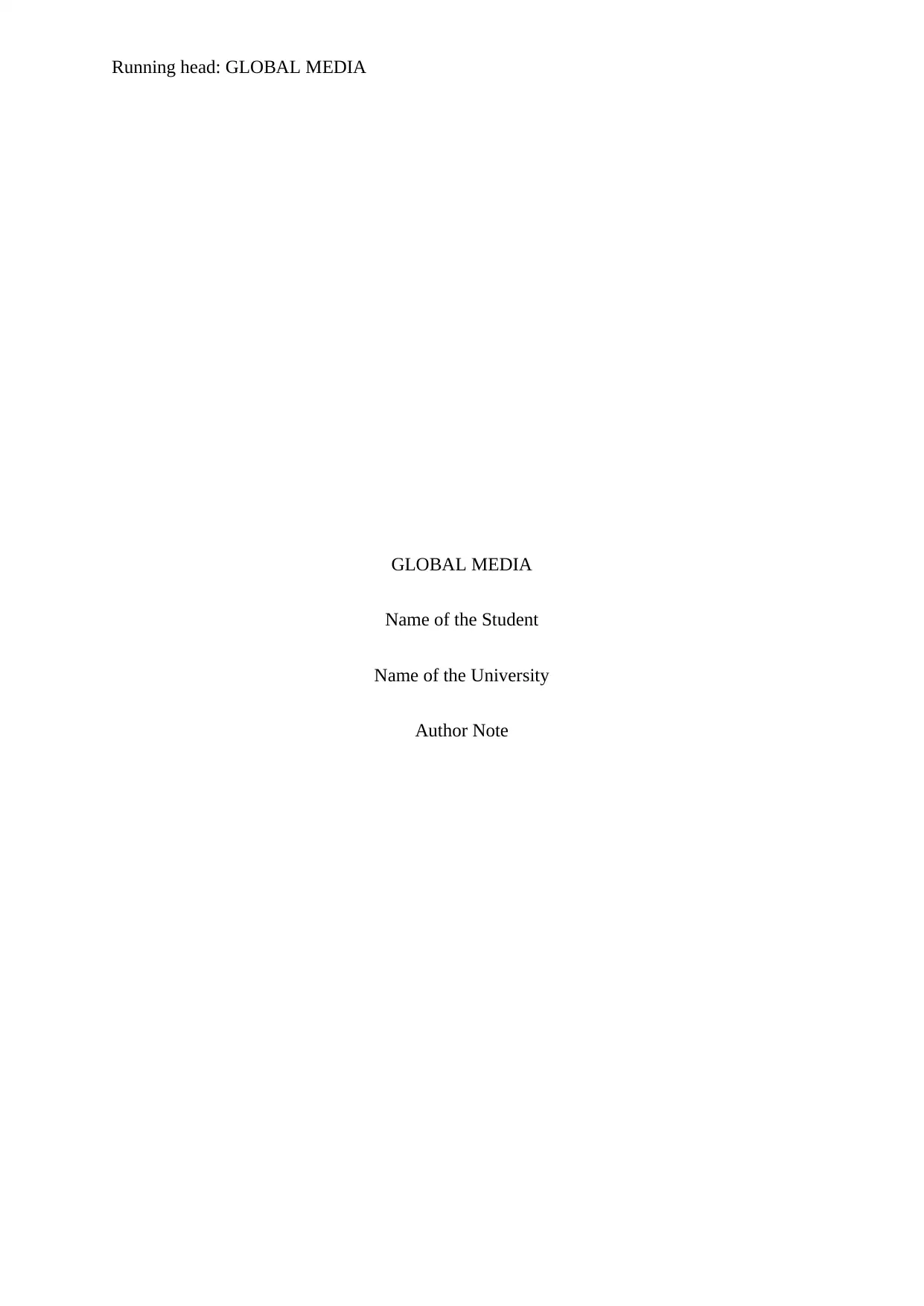
Running head: GLOBAL MEDIA
GLOBAL MEDIA
Name of the Student
Name of the University
Author Note
GLOBAL MEDIA
Name of the Student
Name of the University
Author Note
Paraphrase This Document
Need a fresh take? Get an instant paraphrase of this document with our AI Paraphraser
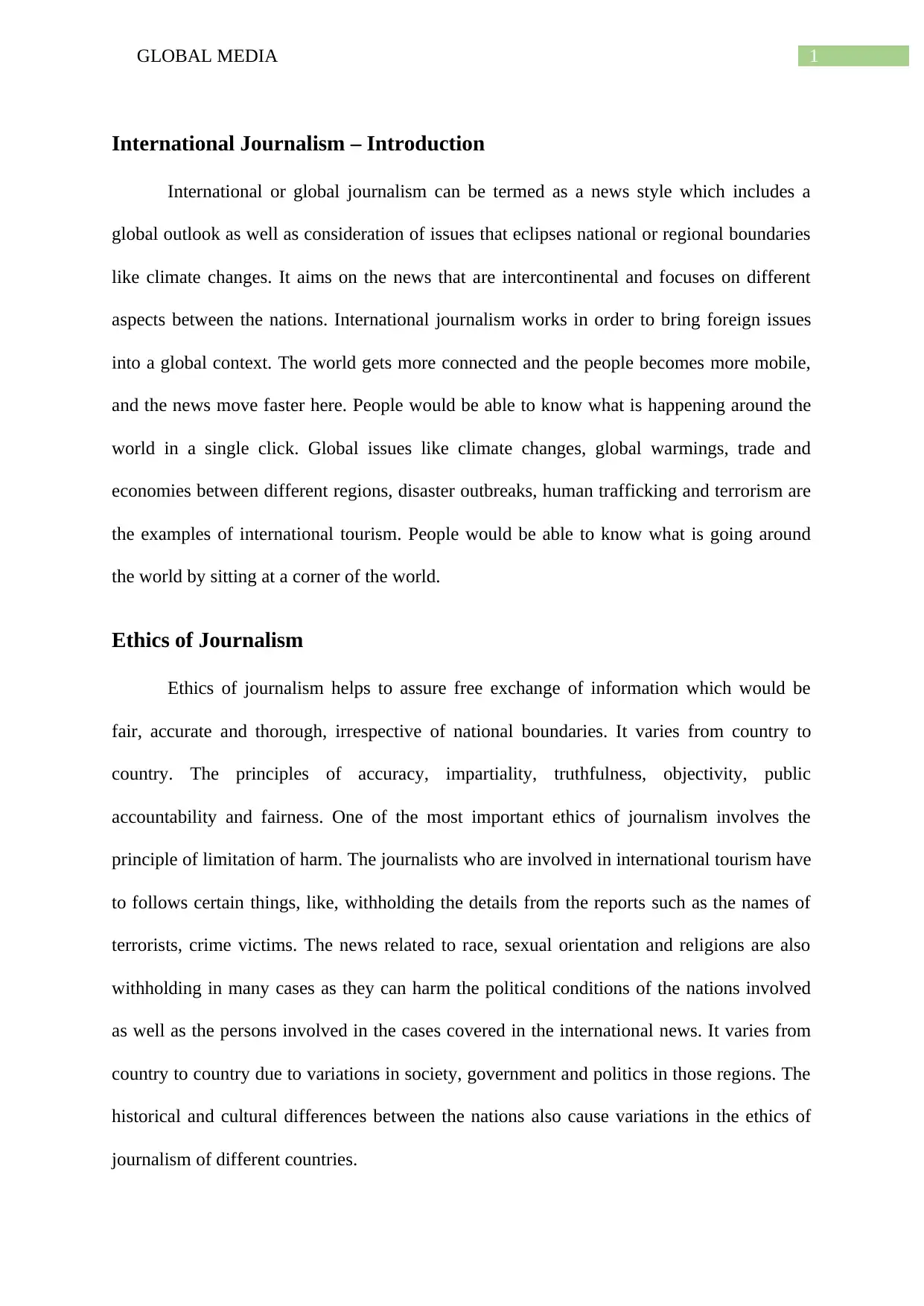
1GLOBAL MEDIA
International Journalism – Introduction
International or global journalism can be termed as a news style which includes a
global outlook as well as consideration of issues that eclipses national or regional boundaries
like climate changes. It aims on the news that are intercontinental and focuses on different
aspects between the nations. International journalism works in order to bring foreign issues
into a global context. The world gets more connected and the people becomes more mobile,
and the news move faster here. People would be able to know what is happening around the
world in a single click. Global issues like climate changes, global warmings, trade and
economies between different regions, disaster outbreaks, human trafficking and terrorism are
the examples of international tourism. People would be able to know what is going around
the world by sitting at a corner of the world.
Ethics of Journalism
Ethics of journalism helps to assure free exchange of information which would be
fair, accurate and thorough, irrespective of national boundaries. It varies from country to
country. The principles of accuracy, impartiality, truthfulness, objectivity, public
accountability and fairness. One of the most important ethics of journalism involves the
principle of limitation of harm. The journalists who are involved in international tourism have
to follows certain things, like, withholding the details from the reports such as the names of
terrorists, crime victims. The news related to race, sexual orientation and religions are also
withholding in many cases as they can harm the political conditions of the nations involved
as well as the persons involved in the cases covered in the international news. It varies from
country to country due to variations in society, government and politics in those regions. The
historical and cultural differences between the nations also cause variations in the ethics of
journalism of different countries.
International Journalism – Introduction
International or global journalism can be termed as a news style which includes a
global outlook as well as consideration of issues that eclipses national or regional boundaries
like climate changes. It aims on the news that are intercontinental and focuses on different
aspects between the nations. International journalism works in order to bring foreign issues
into a global context. The world gets more connected and the people becomes more mobile,
and the news move faster here. People would be able to know what is happening around the
world in a single click. Global issues like climate changes, global warmings, trade and
economies between different regions, disaster outbreaks, human trafficking and terrorism are
the examples of international tourism. People would be able to know what is going around
the world by sitting at a corner of the world.
Ethics of Journalism
Ethics of journalism helps to assure free exchange of information which would be
fair, accurate and thorough, irrespective of national boundaries. It varies from country to
country. The principles of accuracy, impartiality, truthfulness, objectivity, public
accountability and fairness. One of the most important ethics of journalism involves the
principle of limitation of harm. The journalists who are involved in international tourism have
to follows certain things, like, withholding the details from the reports such as the names of
terrorists, crime victims. The news related to race, sexual orientation and religions are also
withholding in many cases as they can harm the political conditions of the nations involved
as well as the persons involved in the cases covered in the international news. It varies from
country to country due to variations in society, government and politics in those regions. The
historical and cultural differences between the nations also cause variations in the ethics of
journalism of different countries.
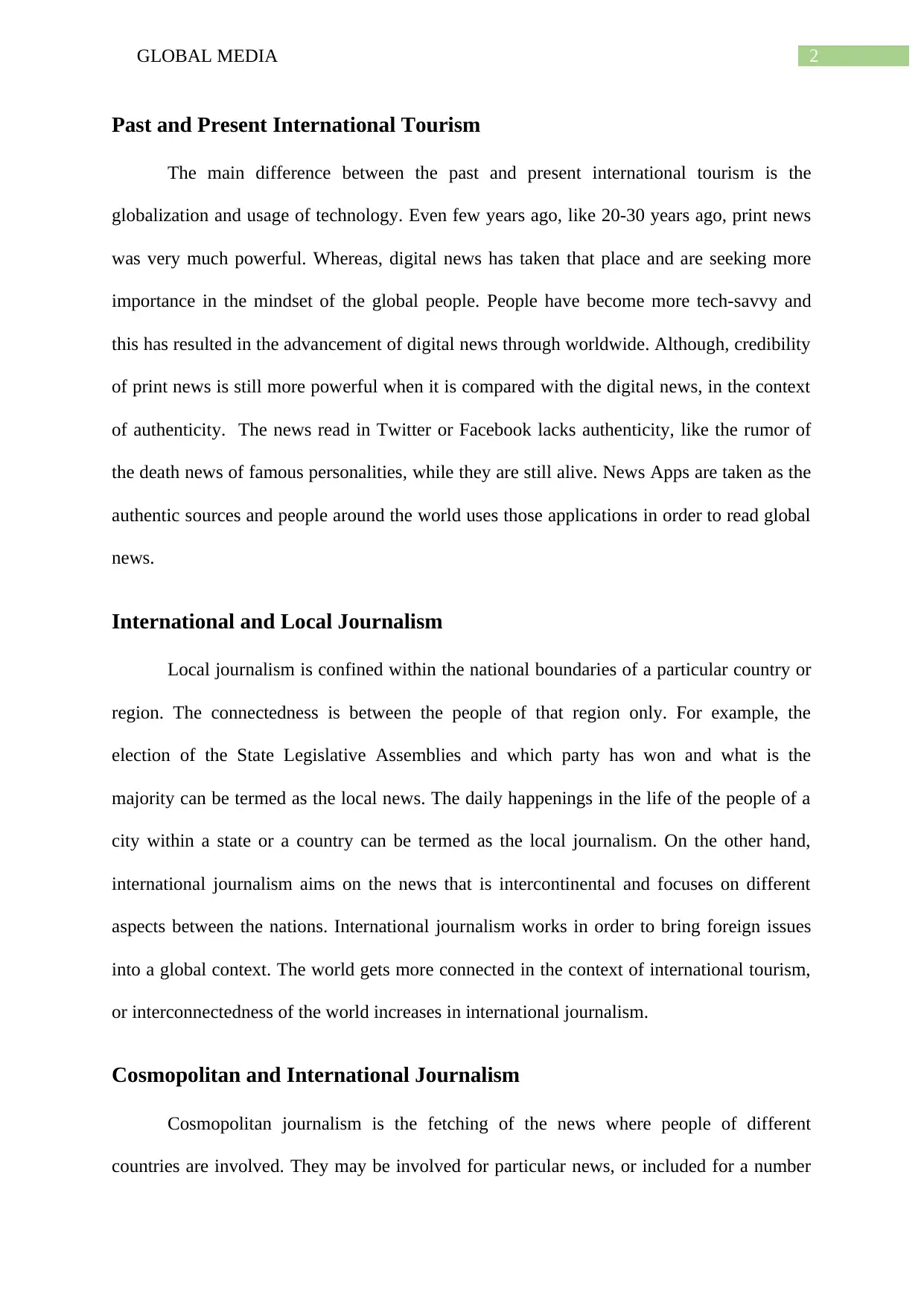
2GLOBAL MEDIA
Past and Present International Tourism
The main difference between the past and present international tourism is the
globalization and usage of technology. Even few years ago, like 20-30 years ago, print news
was very much powerful. Whereas, digital news has taken that place and are seeking more
importance in the mindset of the global people. People have become more tech-savvy and
this has resulted in the advancement of digital news through worldwide. Although, credibility
of print news is still more powerful when it is compared with the digital news, in the context
of authenticity. The news read in Twitter or Facebook lacks authenticity, like the rumor of
the death news of famous personalities, while they are still alive. News Apps are taken as the
authentic sources and people around the world uses those applications in order to read global
news.
International and Local Journalism
Local journalism is confined within the national boundaries of a particular country or
region. The connectedness is between the people of that region only. For example, the
election of the State Legislative Assemblies and which party has won and what is the
majority can be termed as the local news. The daily happenings in the life of the people of a
city within a state or a country can be termed as the local journalism. On the other hand,
international journalism aims on the news that is intercontinental and focuses on different
aspects between the nations. International journalism works in order to bring foreign issues
into a global context. The world gets more connected in the context of international tourism,
or interconnectedness of the world increases in international journalism.
Cosmopolitan and International Journalism
Cosmopolitan journalism is the fetching of the news where people of different
countries are involved. They may be involved for particular news, or included for a number
Past and Present International Tourism
The main difference between the past and present international tourism is the
globalization and usage of technology. Even few years ago, like 20-30 years ago, print news
was very much powerful. Whereas, digital news has taken that place and are seeking more
importance in the mindset of the global people. People have become more tech-savvy and
this has resulted in the advancement of digital news through worldwide. Although, credibility
of print news is still more powerful when it is compared with the digital news, in the context
of authenticity. The news read in Twitter or Facebook lacks authenticity, like the rumor of
the death news of famous personalities, while they are still alive. News Apps are taken as the
authentic sources and people around the world uses those applications in order to read global
news.
International and Local Journalism
Local journalism is confined within the national boundaries of a particular country or
region. The connectedness is between the people of that region only. For example, the
election of the State Legislative Assemblies and which party has won and what is the
majority can be termed as the local news. The daily happenings in the life of the people of a
city within a state or a country can be termed as the local journalism. On the other hand,
international journalism aims on the news that is intercontinental and focuses on different
aspects between the nations. International journalism works in order to bring foreign issues
into a global context. The world gets more connected in the context of international tourism,
or interconnectedness of the world increases in international journalism.
Cosmopolitan and International Journalism
Cosmopolitan journalism is the fetching of the news where people of different
countries are involved. They may be involved for particular news, or included for a number
⊘ This is a preview!⊘
Do you want full access?
Subscribe today to unlock all pages.

Trusted by 1+ million students worldwide
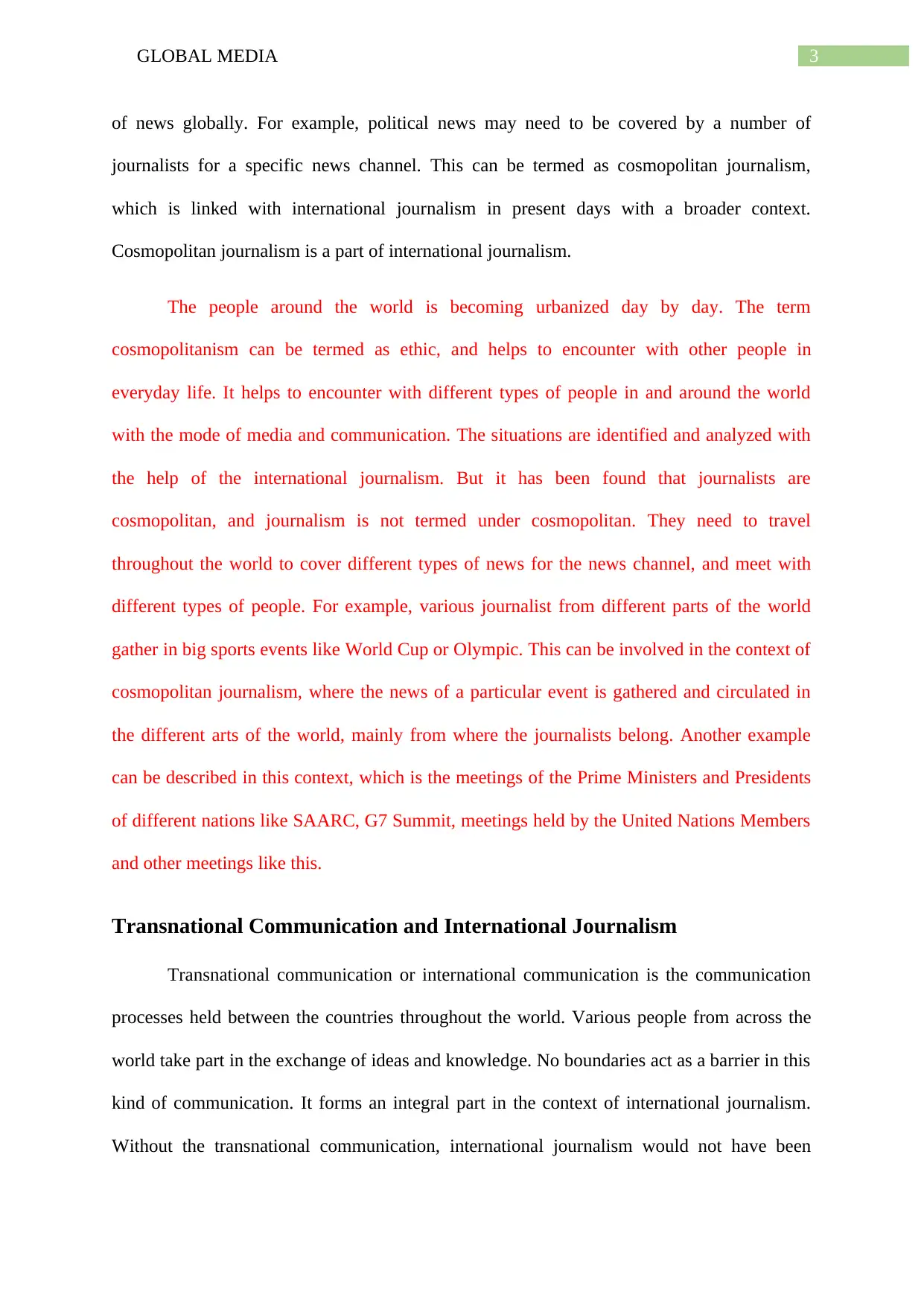
3GLOBAL MEDIA
of news globally. For example, political news may need to be covered by a number of
journalists for a specific news channel. This can be termed as cosmopolitan journalism,
which is linked with international journalism in present days with a broader context.
Cosmopolitan journalism is a part of international journalism.
The people around the world is becoming urbanized day by day. The term
cosmopolitanism can be termed as ethic, and helps to encounter with other people in
everyday life. It helps to encounter with different types of people in and around the world
with the mode of media and communication. The situations are identified and analyzed with
the help of the international journalism. But it has been found that journalists are
cosmopolitan, and journalism is not termed under cosmopolitan. They need to travel
throughout the world to cover different types of news for the news channel, and meet with
different types of people. For example, various journalist from different parts of the world
gather in big sports events like World Cup or Olympic. This can be involved in the context of
cosmopolitan journalism, where the news of a particular event is gathered and circulated in
the different arts of the world, mainly from where the journalists belong. Another example
can be described in this context, which is the meetings of the Prime Ministers and Presidents
of different nations like SAARC, G7 Summit, meetings held by the United Nations Members
and other meetings like this.
Transnational Communication and International Journalism
Transnational communication or international communication is the communication
processes held between the countries throughout the world. Various people from across the
world take part in the exchange of ideas and knowledge. No boundaries act as a barrier in this
kind of communication. It forms an integral part in the context of international journalism.
Without the transnational communication, international journalism would not have been
of news globally. For example, political news may need to be covered by a number of
journalists for a specific news channel. This can be termed as cosmopolitan journalism,
which is linked with international journalism in present days with a broader context.
Cosmopolitan journalism is a part of international journalism.
The people around the world is becoming urbanized day by day. The term
cosmopolitanism can be termed as ethic, and helps to encounter with other people in
everyday life. It helps to encounter with different types of people in and around the world
with the mode of media and communication. The situations are identified and analyzed with
the help of the international journalism. But it has been found that journalists are
cosmopolitan, and journalism is not termed under cosmopolitan. They need to travel
throughout the world to cover different types of news for the news channel, and meet with
different types of people. For example, various journalist from different parts of the world
gather in big sports events like World Cup or Olympic. This can be involved in the context of
cosmopolitan journalism, where the news of a particular event is gathered and circulated in
the different arts of the world, mainly from where the journalists belong. Another example
can be described in this context, which is the meetings of the Prime Ministers and Presidents
of different nations like SAARC, G7 Summit, meetings held by the United Nations Members
and other meetings like this.
Transnational Communication and International Journalism
Transnational communication or international communication is the communication
processes held between the countries throughout the world. Various people from across the
world take part in the exchange of ideas and knowledge. No boundaries act as a barrier in this
kind of communication. It forms an integral part in the context of international journalism.
Without the transnational communication, international journalism would not have been
Paraphrase This Document
Need a fresh take? Get an instant paraphrase of this document with our AI Paraphraser
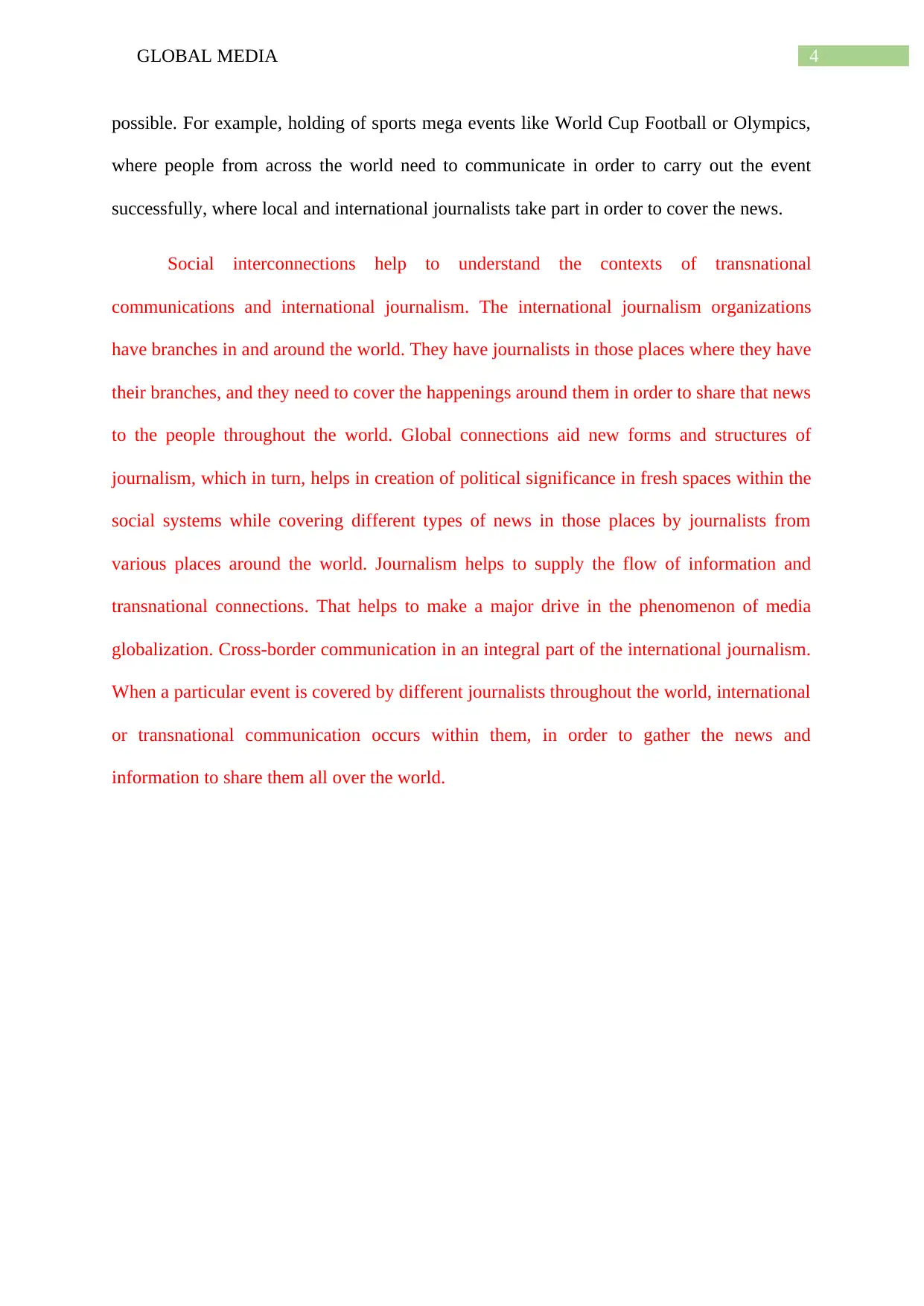
4GLOBAL MEDIA
possible. For example, holding of sports mega events like World Cup Football or Olympics,
where people from across the world need to communicate in order to carry out the event
successfully, where local and international journalists take part in order to cover the news.
Social interconnections help to understand the contexts of transnational
communications and international journalism. The international journalism organizations
have branches in and around the world. They have journalists in those places where they have
their branches, and they need to cover the happenings around them in order to share that news
to the people throughout the world. Global connections aid new forms and structures of
journalism, which in turn, helps in creation of political significance in fresh spaces within the
social systems while covering different types of news in those places by journalists from
various places around the world. Journalism helps to supply the flow of information and
transnational connections. That helps to make a major drive in the phenomenon of media
globalization. Cross-border communication in an integral part of the international journalism.
When a particular event is covered by different journalists throughout the world, international
or transnational communication occurs within them, in order to gather the news and
information to share them all over the world.
possible. For example, holding of sports mega events like World Cup Football or Olympics,
where people from across the world need to communicate in order to carry out the event
successfully, where local and international journalists take part in order to cover the news.
Social interconnections help to understand the contexts of transnational
communications and international journalism. The international journalism organizations
have branches in and around the world. They have journalists in those places where they have
their branches, and they need to cover the happenings around them in order to share that news
to the people throughout the world. Global connections aid new forms and structures of
journalism, which in turn, helps in creation of political significance in fresh spaces within the
social systems while covering different types of news in those places by journalists from
various places around the world. Journalism helps to supply the flow of information and
transnational connections. That helps to make a major drive in the phenomenon of media
globalization. Cross-border communication in an integral part of the international journalism.
When a particular event is covered by different journalists throughout the world, international
or transnational communication occurs within them, in order to gather the news and
information to share them all over the world.
1 out of 5
Related Documents
Your All-in-One AI-Powered Toolkit for Academic Success.
+13062052269
info@desklib.com
Available 24*7 on WhatsApp / Email
![[object Object]](/_next/static/media/star-bottom.7253800d.svg)
Unlock your academic potential
Copyright © 2020–2025 A2Z Services. All Rights Reserved. Developed and managed by ZUCOL.


